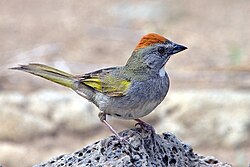Aluntiang-iking Towhee
| Green-tailed Towhee | ||||||||||||||
|---|---|---|---|---|---|---|---|---|---|---|---|---|---|---|
 | ||||||||||||||
| Kabilian a pang-konserbasiun | ||||||||||||||
| Scientific classification | ||||||||||||||
| ||||||||||||||
| Binomial name | ||||||||||||||
| Pipilo chlorurus (Audubon, 1839) |
Ing Aluntiang-iking Towhee, Pipilo chlorurus, iya ing pekamalating towhee, dapot iti ing metung kareng dakal a kayanib kareng "American sparrow" a familia Emberizidae.
Ding kayang palipi makayanga keng kilub na ning Alugang United States, a atin winter a angganan king Mexico ampong mauling danggut ning maulingalbugan ning United States.
Dalerayan
mag-editIng Wikimedia Commons atin yang mediang maki kaugnayan kang/king:
- BirdLife International (2004). Pipilo chlorurus. 2006 IUCN Red List of Threatened Species. IUCN 2006. Retrieved on 12 May 2006. Database entry includes justification for why this species is of least concern
Dakal pang pamamasa
mag-editBook
mag-edit- Dobbs, R. C., P. R. Martin, and T. E. Martin. 1998. Green-tailed Towhee (Pipilo chlorurus). In The Birds of North America, No. 368 (A. Poole and F. Gill, eds.). The Birds of North America, Inc., Philadelphia, PA.
Thesis
mag-edit- Beedy EC. Ph.D. (1982). BIRD COMMUNITY STRUCTURE IN CONIFEROUS FORESTS OF YOSEMITE NATIONAL PARK, CALIFORNIA. University of California, Davis, United States -- California.
- Kerley L. Ph.D. (1994). Bird responses to habitat fragmentation caused by sagebrush management in a Wyoming sagebrush steppe ecosystem. University of Wyoming, United States -- Wyoming.
Articulu
mag-edit- Berry ME & Bock CE. (1998). Effects of habitat and landscape characteristics on avian breeding distributions in Colorado foothills shrub. Southwestern Naturalist. vol 43, no 4. p. 453-461.
- Bulluck L, Fleishman E, Betrus C & Blair R. (2006). Spatial and temporal variations in species occurrence rate affect the accuracy of occurrence models. Global Ecology & Biogeography. vol 15, no 1. p. 27-38.
- Dobbs RC & Martin PR. (2000). Winter nocturnal roost sites and behavior of some desert passerines in western Texas. Western Birds. vol 31, no 2. p. 120-122.
- Erickson RA & Wurster TE. (1998). Confirmation of nesting in Mexico for four bird species from the Sierra San Pedro Martir, Baja California. Wilson Bulletin. vol 110, no 1. p. 118-120.
- Ewert DN. (1980). Recognition of Conspecific Song by the Rufous-Sided Towhee Pipilo-Erythrophthalmus. Animal Behaviour. vol 28, no 2. p. 379-386.
- Garber D. (1969). Green-Tailed Towhee in Racine. Passenger Pigeon. vol 31, no 4.
- Jehle G, Savidge JA & Kotliar NB. (2006). Green-tailed Towhee response to prescribed fire in montane shrubland. Condor. vol 108, no 3. p. 634-646.
- Knopf FL, Sedgwick JA & Inkley DB. (1990). Regional Correspondence among Shrubsteppe Bird Habitats. Condor. vol 92, no 1. p. 45-53.
- Martin TE. (1996). Fitness costs of resource overlap among coexisting bird species. Nature. vol 380, no 6572. p. 338-340.
- Martin TE. (1998). Are microhabitat preferences of coexisting species under selection and adaptive?. Ecology. vol 79, no 2. p. 656-670.
- Martin TE, Scott J & Menge C. (2000). Nest predation increases with parental activity: Separating nest site and parental activity effects. Proceedings of the Royal Society Biological Sciences Series B. vol 267, no 1459. p. 2287-2293.
- Meritt JK. (1976). Green-Tailed Towhee in Gloucester County New-Jersey USA. Cassinia. vol 56, no 28.
- Mindell DP & Sites JWJ. (1987). Tissue Expression Patterns of Avian Isozymes a Preliminary Study of Phylogenetic Applications. Systematic Zoology. vol 36, no 2. p. 137-152.
- Morton ML. (1991). POSTFLEDGING DISPERSAL OF GREEN-TAILED TOWHEES TO A SUB-ALPINE MEADOW. Condor. vol 93, no 2. p. 466-468.
- Noson AC, Schmitz RA & Miller RF. (2006). Influence of fire and Juniper encroachment on birds in high-elevation sagebrush steppe. Western North American Naturalist. vol 66, no 3. p. 343-353.
- Odell EA & Knight RL. (2001). Songbird and medium-sized mammal communities associated with exurban development in Pitkin County, Colorado. Conservation Biology. vol 15, no 4. p. 1143-1150.
- Palacios MG & Martin TE. (2006). Incubation period and immune function: a comparative field study among coexisting birds. Oecologia. vol 146, no 4. p. 505-512.
- Pavlacky DC & Anderson SH. (2004). Comparative habitat use in a juniper woodland bird community. Western North American Naturalist. vol 64, no 3. p. 376-384.
- Ponshair JF. (1980). 8 Species of Birds New for Ottawa County Michigan USA. Jack Pine Warbler. vol 58, no 3.
- Sedgwick JA. (1987). Avian Habitat Relationships in Pinyon-Juniper Woodland. Wilson Bulletin. vol 99, no 3. p. 413-431.
- Spicer GS. (1978). A New Species and Several New Host Records of Avian Nasal Mites Acarina Rhinonyssinae Turbinoptinae. Journal of Parasitology. vol 64, no 5. p. 891-894.
- Zink RM & Blackwell RC. (1996). Patterns of allozyme, mitochondrial DNA, and morphometric variation in four sparrow genera. Auk. vol 113, no 1. p. 59-67.
- Zwartjes PW & Farley GH. (1998). Observations of breeding site fidelity of green-tailed towhees (Pipilo chlorurus) in central New Mexico. Texas Journal of Science. vol 50, no 3. p. 258-261.
Suglung Palual
mag-edit- photo-1, photo-2 and Article Archived Disyembri 26, 2008 at the Wayback Machine fireflyforest
- Article & RangeMaps Archived Setyembri 29, 2007 at the Wayback Machine InfoNatura, NatureServe
- Green-tailed Towhee photo gallery VIREO
- Green-tailed Towhee videos[suglung a mepatad] on the Internet Bird Collection
